The Featured Creatures collection provides in-depth profiles of insects, nematodes, arachnids and other organisms relevant to Florida. These profiles are intended for the use of interested laypersons with some knowledge of biology as well as academic audiences.
Introduction
The redheaded pine sawfly, Neodiprion lecontei (Fitch), is one of numerous sawfly species (including 35 species in the genus Neodiprion) native to the United States and Canada (Arnett 2000) inhabiting mainly pine stands. The ovipositor of all adult female sawflies is saw-like, and is likely where the common name for this group (suborder) originated (PADCNR 2010).
Neodiprion lecontei is an important defoliator of commercially grown pine, as the preferred feeding conditions for sawfly larvae are enhanced in monocultures of shortleaf, loblolly, and slash pine, all of which are commonly cultivated in the southern United States.
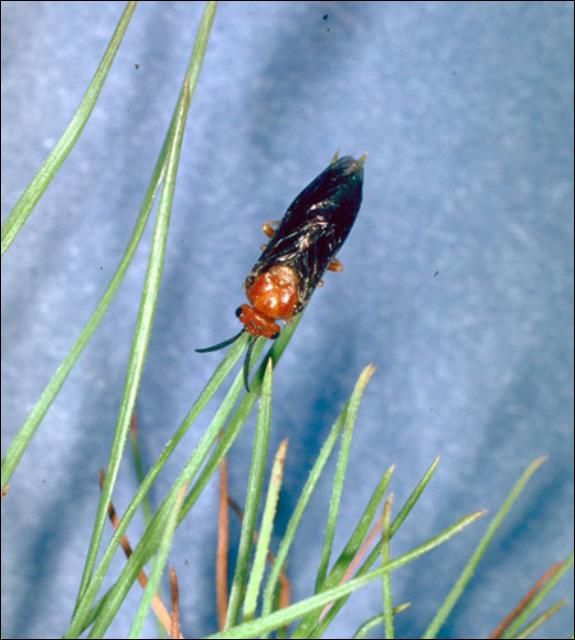
Credit: Lacy L. Hyche, Auburn University, www.forestryimages.org
Distribution
Numerous sawfly species are found in North America. The redheaded pine sawfly is native to the United States and found primarily east of the Great Plains (Wilson 1978), north into Canada, and south into Florida.
Description
Adults
Adult sawflies have a broad "waist," in contrast with many other hymenopterans, and have two pairs of membranous wings. Adults are 0.5–0.85 cm (1/5–1/3 inch) in length, with the females being approximately two-thirds larger than the males. Females are mostly black with a reddish brown head, and occasionally white on the sides of the abdomen. Females have 19-segmented, serrated (saw-toothed) antennae, and male antennae are featherlike (Hyche 1999).
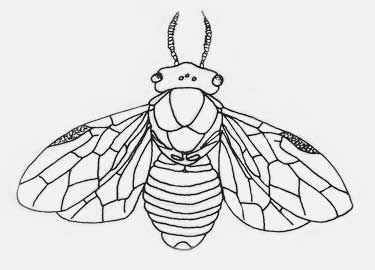
Credit: Adapted from Atwood 1961

Credit: Arnold T. Drooz, USDA Forest Service, www.forestryimages.org
Eggs
Females deposit an individual egg in a slit made with the ovipositor into the pine needle. The adult redheaded pine sawfly can lay from 100 to 120 eggs at a time. The eggs are oval, smooth and shiny, translucent white and approximately 1.8 mm (1/12 in) long and 0.6 mm (1/40 in) wide when ready to hatch (Wilson 1978). Oviposited eggs are evident by small discolored patches in a row on the needle.

Credit: Lacy L. Hyche, Auburn University, www.forestryimages.org
Larvae
Larvae emerge after two to three weeks and are whitish with a brown head capsule. As larvae mature, they become yellow to green with brown heads. Mature larvae are approximately 2.5 cm (1 in) long and have a red to reddish-orange head. The mature larvae are yellow to yellow-green in color and have four to eight rows of black spots lengthwise along the body. Each larva has three pairs of thoracic legs and six to seven pairs of prolegs (Hyche 1999). Redheaded pine sawfly larvae may lift the front and rear portions of their bodies in a defensive mechanism if threatened and regurgitate a chemical sequestered from the pine needles in an attempt to thwart potential predators.
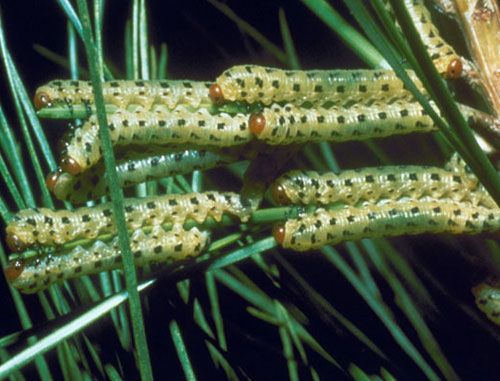
Credit: Ronald F. Billings, Texas Forest Service, www.forestryimages.org
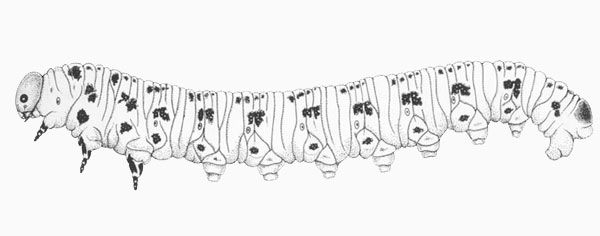
Prepupae and Pupae
The cocoon is spun in the upper layer of the soil and is approximately 1.25 cm (1/2 in) in length. The cocoon is a reddish-brown paper-like cylinder with rounded ends (Wilson 1978). Prepupae overwinter in cocoons and, once adults emerge, the cocoons are left behind with a large circular hole in one end.
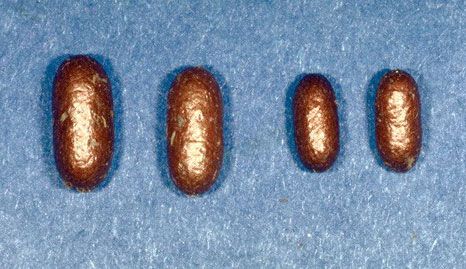
Credit: Lacy L. Hyche, Auburn University, www.forestryimages.org
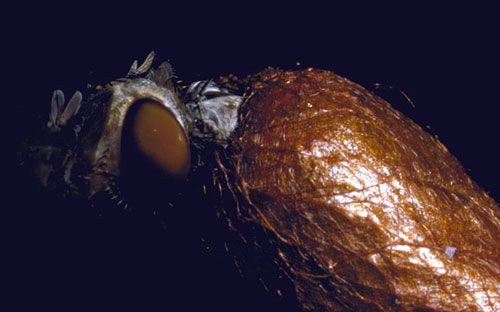
Credit: Arnold T. Drooz, USDA Forest Service, www.forestryimages.org
Life Cycle
An adult female creates slits in a pine needle and lays one egg per slit. Needles that have eggs laid in them look spotted or banded with alternating green and yellow patches. In approximately four weeks, larvae emerge and feed on the pine needles in large gregarious groups. In approximately four more weeks, larvae drop to the ground below the tree they were feeding on and begin to spin cocoons in the leaf litter or top layer of soil. The larvae can overwinter here, and possibly stay dormant in the prepupal state for more than a year under certain conditions (Hyche 1999). Adults emerge by cutting the tip of the cocoon off, leaving a circular hole in one end of the cocoon, which resembles a cap. Redheaded pine sawflies north of New York have approximately one generation per year, while redheaded pine sawflies south of New York may have two to three generations per year (Wilson 1978). As many as three generations a year may occur in Florida (Buss 2010).
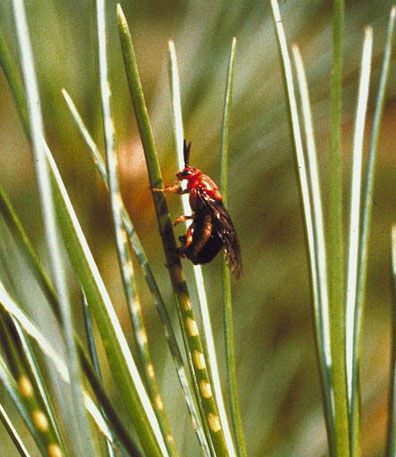
Credit: James McGraw, North Carolina State University, www.forestryimages.org
Hosts
Young, open-growing pine trees, under 4.6 m (15 ft) tall, are especially vulnerable. Although hard pines are preferred, larvae will feed on a variety of pine, cedar, and fir species if preferred food sources are exhausted. In Florida, the preferred food sources for redheaded pine sawfly include: shortleaf pine (Pinus echinata), loblolly pine (Pinus taeda), longleaf pine (Pinus palustris), slash pine (Pinus elliottii), Virginia pine (Pinus virginiana), and scotch pine (Pinus sylvestris). Although not native to Florida, Swiss mountain pine (Pinus mugo) is occasionally used as a landscape plant in northern Florida and is a documented host and preferred food source of the redheaded pine sawfly in more northern climates (Baker 2010). In Canada and the northern United States, jack pine (Pinus banksiana), and red pine (Pinus resinosa) are the preferred food sources for redheaded pine sawfly larvae.
Norway spruce (Picea abies) and deodar cedar (Cedrus deodara) are occasionally used as landscape plants in northern Florida, and they are documented as non-preferred food sources of the redheaded pine sawfly (Shetlar 2000). Additionally, larvae feed on white pine (Pinus strobus) and larch (Larix spp.) north of Florida, but these trees are also considered a non-preferred food source for the redheaded pine sawfly (Shetlar 2000).
Economic Importance
Redheaded pine sawfly larvae are gregarious feeders, capable of completely stripping small pine trees of foliage. Younger larvae eat the outer edges of pine needles leaving behind the central tissue, which wilts and dies, forming what looks like dried straw. This makes sawfly damage distinctive (Hyche 1999). Older larvae eat the entire needle, and if complete defoliation occurs, groups of larvae will move to the nearest acceptable food source and continue feeding. When foliage becomes scarce, larvae will even feed on the soft bark tissue of defoliated trees (Hyche 1999).
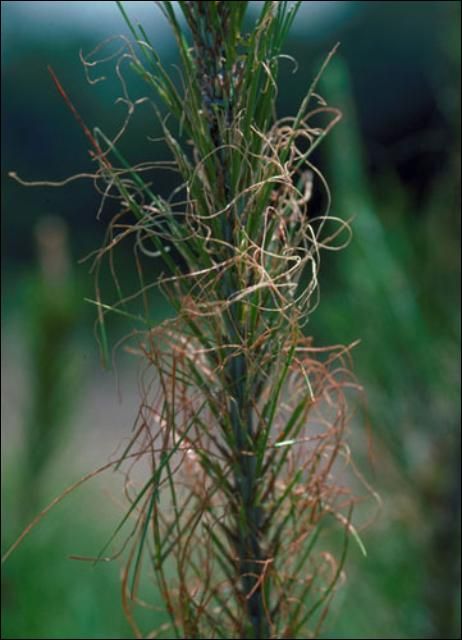
Credit: G. Keith Douce, University of Georgia, www.forestryimages.org
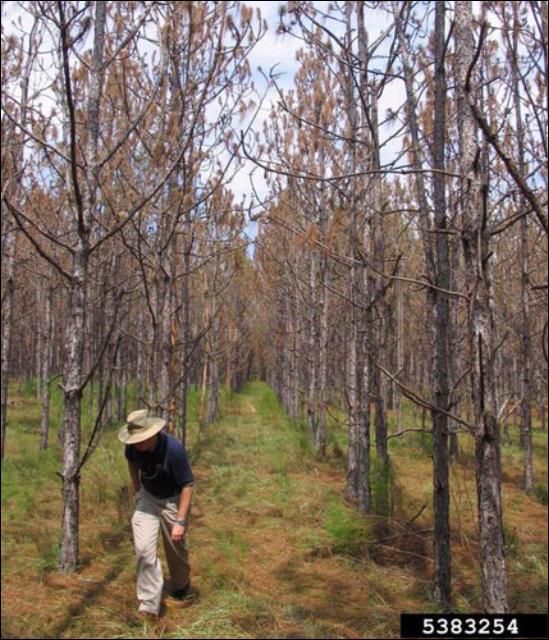
Credit: Albert Mayfield, Florida Department of Agriculture and Consumer Services, www.forestryimages.org
Of particular vulnerability are commercial pine stands during reseeding cycles, where large populations of a single species at a similar age provide both young foliage and trees of a desirable height (under 4.6 m or 15 ft) for redheaded pine sawfly infestation (Wilson 1978). These monoculture conditions can encourage an outbreak of redheaded pine sawfly. Non-preferred feeding can also occur on the outskirts of pine plantations, where colonies of larvae may infest neighboring trees as they exhaust the immediate preferred food source (Hyche 1999).
Management
Biological Control
Natural enemies are numerous (58 different species are recorded) and disease, viruses, and predators regularly control populations of redheaded pine sawfly (Van Driesche 1996). Larvae are also susceptible to harsh weather conditions such as extreme heat and cold.
Cultural/Mechanical Control
For small scale control, larvae can be mechanically or physically removed. Hand picking can be an effective form of control for the homeowner and can be conducted by striking the branch sharply causing the larvae to fall off. The falling larvae can be caught with a bucket of soapy water held underneath the branch (Shetlar 2000).
Chemical Control
Horticultural soaps and oils are effective for larval control, but the application should target young larvae (Shetlar 2000). Sprays may be ineffective on a small scale, as the insecticide may not penetrate deep into the foliage and therefore not eliminate a majority of larvae. For commercial applications, young larvae should be targeted by more forceful spraying to thoroughly penetrate foliage. Spraying is only necessary if larval populations are reaching damaging thresholds (Wilson 1978).
Selected References
Arnett Jr RH. 2000. American insects: A handbook of the insects of America north of Mexico. CRC Press. Boca Raton. 1003 pp.
Atwood CE. 1961. Present status of the sawfly family Diprionidae (Hymenoptera) in Ontario. Proceedings of the Entomological Society of Ontario 91: 205-215.
Baker JR. Redheaded pine sawfly. Insect and Related Pests of Shrubs. North Carolina State University. http://ipm.ncsu.edu/ag189/html/Redheaded_Pine_Sawfly.html (30 July 2014)
Buss EA. 2010. Sawflies and leafcutting bees. pp. 257-258. In Koehler PG, Buss EA, Kern Jr WH, Pereira RM. Pests in and around the Florida home (fourth edition). University of Florida/IFAS. SP 134. 326 pp.
Hyche LL. (May 1999). The redheaded pine sawfly: A guide to recognition and habits in Alabama. Department of Entomology and Plant Pathology. Auburn University.http://www.ag.auburn.edu/enpl/bulletins/redheadedpinesawfly/redheadedpinesawfly.htm (30 July 2014)
(PADCNR). Redheaded pine sawfly. Forest Health Fact Sheets. Pennsylvania Department of Conservation and Natural Resources. (no longer available online)
Shetlar DJ. (2000). Redheaded pine sawfly. Insect and Pest Series Index. Ohio State University. (no longer available online)
Van Driesche RG, Healy S, and Reardon RC. 1996. Redheaded pine sawfly. pp. 105- 106. In Van Driesche RG, Healy S, Reardon RC. Biological control of arthropod pests of the Northeastern and North Central Forests in the United States: A Review and Recommendations. Forest Health Technology Enterprise Team. Morgantown, West Virginia. 257 pp.
Wilson WF, Averill RD. 1978. Redheaded pine sawfly. Forest Insect & Disease Leaflet 14. United States Department of Agriculture Forest Service. 4 pp.